Cracker Jack and caribou: Are we failing Canada’s species at risk?
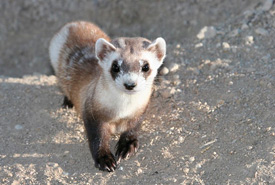
Black-footed ferret (Photo by U.S. Fish & Wildlife Service Mountain Prairie)
I lost my Cracker Jack wildlife cards sometime in the 1980s, but the images printed on the cards are still vivid in my mind. The small cards came wrapped in clear plastic and featured a holographic image of a wildlife species in danger. I can still see the pencil marks in the top drawer of my old desk, where I marked lines to keep them organized. There was a special area in my drawer reserved for the handful of species that lived in my country, and were at risk of extinction.
I started collecting my Cracker Jack wildlife cards around the time when Canada started to systematically identify the wildlife species that were most at risk. Formed in 1977, the Committee on the Status of Endangered Wildlife in Canada (COSEWIC) has provided science-based assessments of wildlife that is most at risk of being lost from Canada.
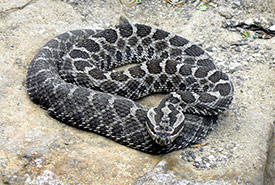
Massasauga rattlesnake (Photo by Tim Vickers)
It was a small list of Canadian wildlife in danger back in the late 1970s. My most treasured Cracker Jack cards featured the Vancouver Island marmot, wood bison, peregrine falcon, black-footed ferret and whooping crane. To the credit of the Cracker Jack card people, they even included some lesser-known species such as shortnose sturgeon and Massasauga rattlesnake, and species that had almost disappeared from southern Canada, including the grizzly bear and timber wolf (now called the grey wolf). Over-hunting and pollution were the key issues noted on the back of the cards for most species.
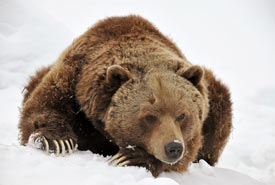
Grizzly bear (Photo by Caroline Henri)
A growing list of wildlife in danger
That list of wildlife in danger has almost doubled since I started working at the Nature Conservancy of Canada (NCC) in 2002. Today, there are 748 species that have been assessed as at risk in Canada by COSEWIC. Part of this steep increase has resulted from more species being assessed.
COSEWIC meets twice a year to assess species based on factors such as range size, number of individuals, population trends and projected changes in habitat. Species are then categorized as extinct, extirpated, endangered, threatened, special concern, data deficient or not at risk. Species assessed by COSEWIC then go through a second assessment by Environment Canada and Climate Change to identify how they will be listed under the federal Species at Risk Act (SARA). Once listed under SARA, there are efforts to develop a plan to recover or manage the species.
The increase in the number of assessments and better tools to identify species that could be endangered definitely account for many “new” species at risk. But there are also many species that were common 40 years ago that have genuinely declined. Many bat species are now endangered because the introduction of white-nose syndrome has devastated colonies across eastern North America. Birds that were once common, including barn swallow, Sprague’s pipit and eastern whip-poor-will, have declined by over 70 per cent since I was kid in the 70s. Nine caribou populations are now at risk.
How do we keep the list from growing?
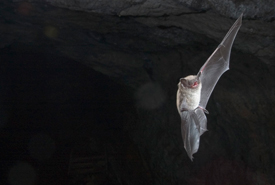
Little brown myotis (Photo by Brock Fenton)
The rapid, steady growth in the number of at-risk species worries me. It sometimes even makes me wonder if our conservation efforts are failing these species, and failing future generations of Canadians. The good news is that there has been a renewed effort to officially list species under SARA so that recovery and management plans can be developed. The challenge is going to be: how do we recover all of those species and keep the list from growing?
We know that Canada's most endangered species aren't evenly distributed. Most species at risk are generally located in southern Canada, where the conservation and restoration of those habitats continues to compete with human uses of land and water. If we focus our conservation efforts on these hotspots, we simultaneously protect the habitat of many rare species.
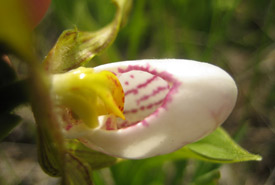
Small white lady's-slipper (Photo by Melissa Grantham)
Where the species at risk are
NCC has been protecting species at risk hotspots for many years. Most of these hotspots are within landscapes that are dominated by human activities where we are continuing to lose prairies, forests and wetlands. By focusing our conservation efforts on some of the best habitat remnants and restoring areas around them, land protection and management can reduce key threats to at-risk species and start to move the needle on their recovery.
For example, on NCC’s Stone Road Alvar property on Pelee Island in Lake Erie, there are currently 19 at-risk species that have been assessed by COSEWIC as endangered, threatened or special concern. BC’s Sage and Sparrow property in the South Okanagan Similkameen has 20. NCC’s land protection and management of tallgrass prairie in Manitoba was partially responsible for the change in status of small white lady's-slipper from endangered to threatened in 2015.
Species that have their habitats within conservation lands generally face fewer threats. When we reduce the threat, we reduce the risk of extinction. In time, their status can be improved, and we can start to see species shift into lower risk categories or, ideally, be removed from the list.
In addition to reducing threats, real recovery comes by increasing the number of individuals and locations, and expanding habitats and the ranges of at-risk species. By restoring forests, savannahs and wetlands, the amount of habitat that is available for at-risk species increases, which is hopefully reflected through an increase in their numbers. In some cases we need to help restore populations and expand ranges through reintroductions.
NCC has reintroduced burrowing owl and plains bison back to properties that are within their historic range. Increasing the number of locations a species occupies also reduces its risk, and starts the recovery process.
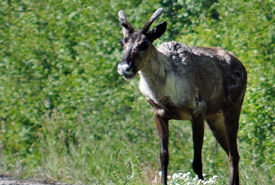
Caribou on Darkwoods, British Columbia (Photo by NCC)
Seeing the world that could be
The factors leading to endangerment for some of Canada’s species is complicated, and can’t always be solved by land conservation alone. Invasive diseases are impacting trees. Climate change is increasing the threat to caribou, whitebark pine and collared pika. Poaching threatens medicinal plants and species sold in the pet trade.
But we do know how to recover endangered species, even when it’s complicated. My old Cracker Jack wildlife cards included osprey. Their numbers had dwindled because persistent pesticides such as DDT made the shells of their eggs so thin and fragile, they often broke when the parents sat on the nest. While never officially listed in Canada, their numbers had plummeted by the 1970s and they were rare. Today, they're a more common sight, and I’ve stopped pointing out osprey nests in the light towers at baseball diamonds to my son.
The opportunity to recover Canada’s at-risk wildlife can inspire us to see the world that could be. Places and habitats that have almost been lost can be restored. Species that were at the edge of extinction can be gently pulled back. Recovery of our most endangered plants and animals is possible, but we need to do more.


